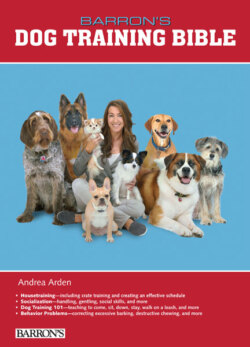Читать книгу B.E.S. Dog Training Bible - Andrea Arden - Страница 11
На сайте Литреса книга снята с продажи.
The Evolution of the Canine-Human Bond
ОглавлениеIn the beginning, dogs most likely chose to be close to people because this proximity provided opportunities to scavenge leftovers. Therefore, in some ways this became a process of self-domestication. People wisely recognized the benefits of accepting canine companionship in their lives. Dogs aided man’s struggle for survival, and they were ultimately employed for many purposes, including guarding, hunting, hauling, and providing warmth. Like humans, most dogs were required to multi-task, and as such, they became invaluable members of what could be deemed a mutual admiration society.
The enduring friendship between dogs and people is based largely on the fact that both are highly social creatures. Dogs understand that it is much easier to survive as a member of a group rather than on their own. In the wild, these relationships are formed with members of their own species, known as packs. Through the process of domestication, dogs also learned to form cooperative relationships with other species, and they were superbly suited to aid people in countless ways. At this point, it might be more accurate to say they have become members of our families.
Selective Breeding
As this mutually beneficial relationship progressed, people began to prize dogs for specific qualities. Some were valued for their alertness, while others were valued for speed, or responsiveness to learning. This was the beginning of selective breeding for desired traits. It has resulted in hundreds of breeds that encompass a vast array of distinct characteristics. In every breed, certain traits are accentuated to improve their ability to assist us, and in some cases simply to be beautiful, enjoyable companions. For instance, the sighthounds were bred for extreme speed and keen eyesight, to hunt fast game over the flat open terrain of the Middle East. On the other side of Asia, the Pekingese was developed in China’s Imperial Court to resemble a lion, guard the palace, and act as a loyal, dignified companion to the royal family.
TRAINING TRUTH
Focus on Companion Dogs
People certainly valued canine companionship during the early stages of the canine-human bond. But at that point in time, no one had the resources to keep dogs solely as friends. People were far more concerned with the contribution that dogs could make toward everyone’s survival. As a result, they became more specialized for particular jobs. We have spent thousands of years accentuating, appreciating, and benefiting from every breed’s unique working function. Our world has changed, and our reliance on dogs as working companions has decreased. There are still plenty of dogs with day jobs such as bomb, drug, and cancer-sniffing dogs, as well as police and service dogs—to name just a few. However, the focus of our relationships with our dogs has shifted from work to companionship. Regardless of their original function, most dogs now live their lives as our companions. Some breeds adapt to this modern role more easily than others. In some cases, it is at odds with the breed’s underlying behavioral traits.
